Unit 4 Lesson 20 No Stopping课件+音频(共25张PPT) 冀教版八年级上册
文档属性
| 名称 | Unit 4 Lesson 20 No Stopping课件+音频(共25张PPT) 冀教版八年级上册 | 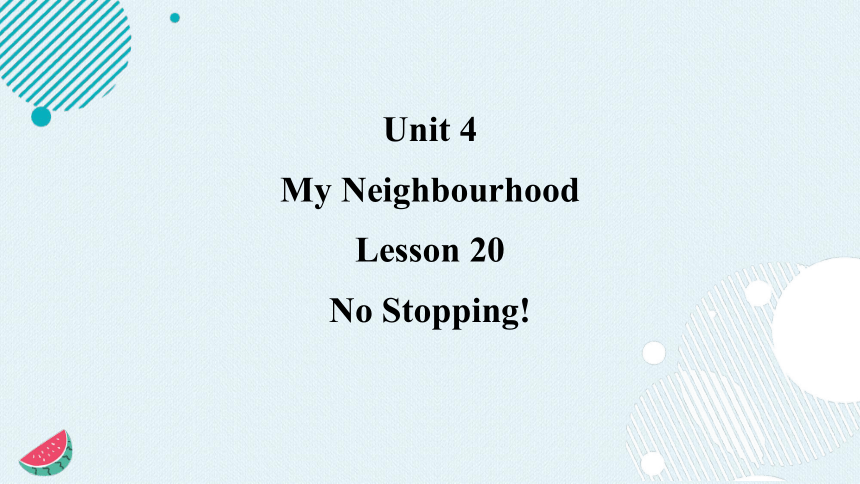 | |
| 格式 | pptx | ||
| 文件大小 | 1.8MB | ||
| 资源类型 | 教案 | ||
| 版本资源 | 冀教版 | ||
| 科目 | 英语 | ||
| 更新时间 | 2024-08-06 11:24:16 | ||
图片预览



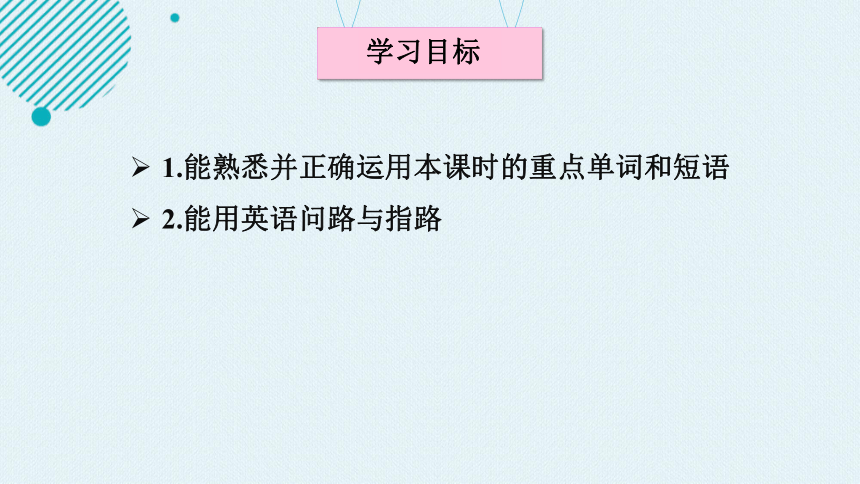
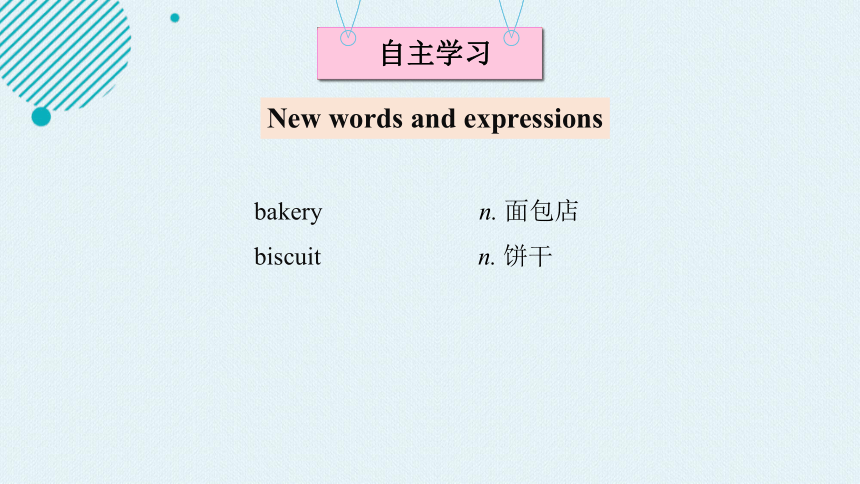
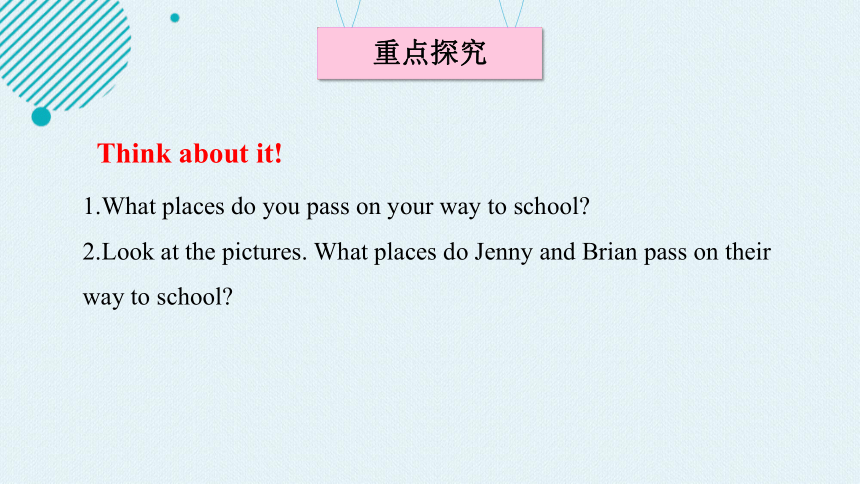

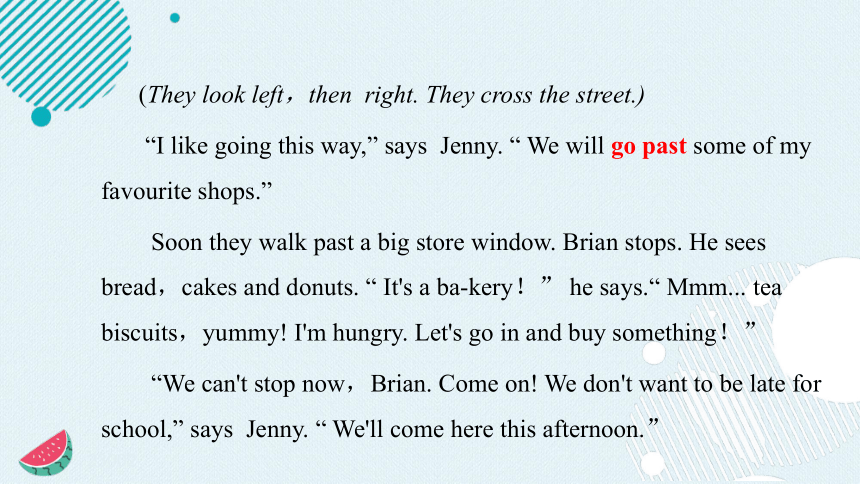
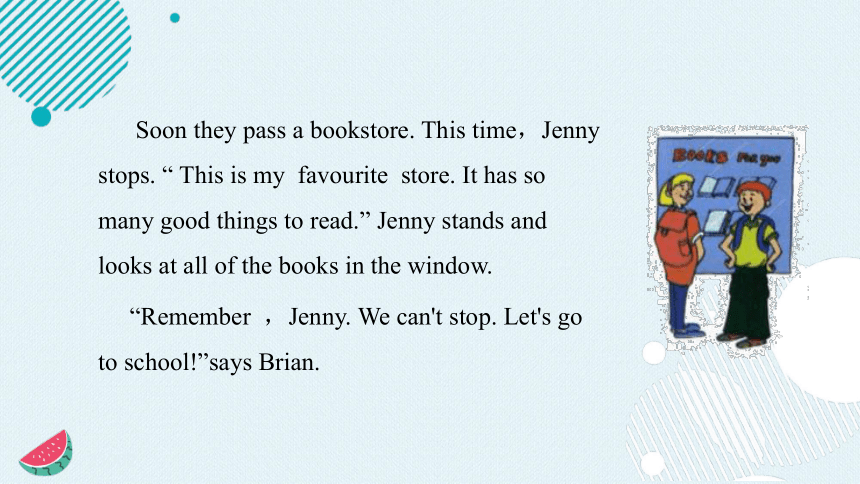
文档简介
(共25张PPT)
Unit 4
My Neighbourhood
Lesson 20
No Stopping!
学习目标
重点探究
自主学习
学习导航
当堂检测
课堂总结
拓展提升
新课导入
1. How do you get to school every day
2. What places do you pass on the way
3. Do you stop anywhere
Free Talk
学习目标
1.能熟悉并正确运用本课时的重点单词和短语
2.能用英语问路与指路
自主学习
New words and expressions
bakery n. 面包店
biscuit n. 饼干
重点探究
Think about it!
1.What places do you pass on your way to school
2.Look at the pictures. What places do Jenny and Brian pass on their way to school
Jenny and Brian are on their way to school. They are walking because it's sunny.
“This is fun,”says Brian. “Usually we take the school bus.”
“I want to show you the neighbourhood this morning,”says Jenny. “ The bus goes too fast. When you walk,you can see things better.”
(They come to a corner.)
“Do we go this way now?”asks Brian. He is pointing to the right.
“No. Turn left,”says Jenny. “ Then cross the street.”
(They look left,then right. They cross the street.)
“I like going this way,” says Jenny. “ We will go past some of my favourite shops.”
Soon they walk past a big store window. Brian stops. He sees bread,cakes and donuts. “ It's a ba kery!” he says.“ Mmm... tea biscuits,yummy! I'm hungry. Let's go in and buy something!”
“We can't stop now,Brian. Come on! We don't want to be late for school,” says Jenny. “ We'll come here this afternoon.”
Soon they pass a bookstore. This time,Jenny stops. “ This is my favourite store. It has so many good things to read.” Jenny stands and looks at all of the books in the window.
“Remember ,Jenny. We can't stop. Let's go to school!”says Brian.
Let’s Do It!
1
Read the lesson and write true (T) or false (F).
1.Jenny and Brian are on their way to school.( )
2.They usually ride bicycles to school.( )
3.Brian wants to go into a bakery and buy something.( )
4.Jenny's favourite store is the bookstore.( )
5.They can stop to buy something or read books.( )
T
T
T
F
F
2
Fill in the blanks with the correct forms of the words in the box.
point cross neighbourhood past
1.I want to show you the ______________this morning.
2.“Do we go this way now?” asks Brian. He is ________ to the right.
3.They look left,then right. They ________ the street.
4.We will go ________ some of my favourite shops.
neighbourhood
pointing
cross
past
3
Match the statements on the left with the reasons
on the right.
We didn't have fun
The teacher is angry
I often go to the library
You can't go by yourself
because I like reading.
because you're not old enough.
because Peter is late for school.
because he went mountain climbing.
because the weather was bad.
He is tired
4
Work in pairs. Talk about what you do on your way to school. Then make up a dialogue with your partner.
You can ask the following questions:
How do you usually get to school
What places do you pass on your way to school
What are your favourite places
Do you stop anywhere Why or why not?
Li Ming:Hi,Wang Wei! How do you usually get to school
Wang Wei:I usually walk to school. Sometimes I go to school by bike.
Li Ming:What places do you pass on your way to school
Wang Wei:I go past a bookstore, a bakery,a toy store and a flower shop..
Li Ming:What are your favourite places
Wang Wei:The bookstore and the toy store.
Li Ming:Do you stop anywhere Why
Wang Wei:Sometimes I will stop. I will go to buy some books. Books are my favourite.
拓展提升
language points
1.No stopping!
“No+动名词”是英语中一种表示“禁令”的句式,通常用作公共场所的警示,相当于否定的祈使句(Don’t do…),意为“不许……,严禁……”。
No Parking!禁止停车!
No Stopping!禁止停留!
No Smoking!禁止吸烟!
【拓展】 no后也可以跟名词(短语),表示“严禁……,不许……”。
No Photos!禁止拍照!
2.Jenny and Brian are on their way to school.
on one’s/the way to 意思是“在去……的路上”。后接home,here,there等地点副词时,省略to。
on his way home
在他回家的路上
I met Li Ming on my way to the library.
我在去图书馆的路上遇到了李明。
3.Usually we take the school bus.
take a bus和 by bus 都表示“乘公共汽车”。
You can go to the zoo by bus.
你可以乘公共汽车去动物园。
They took the train to Hangzhou yesterday.
他们昨天乘火车去了杭州。
4.He is pointing to the right.
point to与 point at 都有“指……”的含义,一般情况下可互换,但二者侧重点不同。
point to 侧重指方向或远处的事物,意为“指向”;
point at 侧重指对象或近距离的目标,意为“指着”。
5.Then cross the street.
cross是及物动词,意为“穿过”,在句中作谓语;
across是介词,意为“横过……;从……一边到另一边”,后加名词构成介词短语,表示位置。
Bob,cross this bridge and you can see that hotel.
鲍勃,穿过这座桥,你就会看到那家旅馆。
There is a market across from the park.
在公园对面有一个市场。
6.We will go past some of my favourite shops.
past在此作介词,意思为“经过”,常用短语go/walk past走过,经过。
go past有时也可以用go by 来代替,此处by也作介词,意为“经过”。
Tom walks past/by some shops on his way to school.
汤姆去学校的路上经过一些商店。
【拓展】 pass是动词,表示“经过”。 pass 相当于 go past/walk past。
当堂检测
Ⅰ. 根据汉语意思完成句子
1.我通常坐公交车去学校。
Usually I to school.
2.我们将会路过我最喜欢的那家书店。
We will my favourite bookstore.
3.我不想上学再迟到了。
I don’t want to school again.
take a bus
walk/go past
be late for
当堂检测
Ⅰ. 根据汉语意思完成句子
4.在他回家的路上,他碰到了他最好的朋友。
He met his best friend .
5.他正指向左边。
He the left.
on his way home
is pointing to
当堂检测
Ⅱ. 选词填空
1.Can you tell me the way (of/to)the hospital
2.If you leave for the zoo from here,you will go (by/to)a park.
3.Look! There are (so/such)many people in the park.
4.Let’s go to the library.It has lots of good books (reading/to read).
5.Brian is not (enough strong/strong enough)to carry the big box.
to
by
so
to read
strong enough
课堂总结
Unit 4
lesson 20
重点短语
重点单词
corner
cross
remember
no stopping
on one's way
take a bus
point to
Unit 4
My Neighbourhood
Lesson 20
No Stopping!
学习目标
重点探究
自主学习
学习导航
当堂检测
课堂总结
拓展提升
新课导入
1. How do you get to school every day
2. What places do you pass on the way
3. Do you stop anywhere
Free Talk
学习目标
1.能熟悉并正确运用本课时的重点单词和短语
2.能用英语问路与指路
自主学习
New words and expressions
bakery n. 面包店
biscuit n. 饼干
重点探究
Think about it!
1.What places do you pass on your way to school
2.Look at the pictures. What places do Jenny and Brian pass on their way to school
Jenny and Brian are on their way to school. They are walking because it's sunny.
“This is fun,”says Brian. “Usually we take the school bus.”
“I want to show you the neighbourhood this morning,”says Jenny. “ The bus goes too fast. When you walk,you can see things better.”
(They come to a corner.)
“Do we go this way now?”asks Brian. He is pointing to the right.
“No. Turn left,”says Jenny. “ Then cross the street.”
(They look left,then right. They cross the street.)
“I like going this way,” says Jenny. “ We will go past some of my favourite shops.”
Soon they walk past a big store window. Brian stops. He sees bread,cakes and donuts. “ It's a ba kery!” he says.“ Mmm... tea biscuits,yummy! I'm hungry. Let's go in and buy something!”
“We can't stop now,Brian. Come on! We don't want to be late for school,” says Jenny. “ We'll come here this afternoon.”
Soon they pass a bookstore. This time,Jenny stops. “ This is my favourite store. It has so many good things to read.” Jenny stands and looks at all of the books in the window.
“Remember ,Jenny. We can't stop. Let's go to school!”says Brian.
Let’s Do It!
1
Read the lesson and write true (T) or false (F).
1.Jenny and Brian are on their way to school.( )
2.They usually ride bicycles to school.( )
3.Brian wants to go into a bakery and buy something.( )
4.Jenny's favourite store is the bookstore.( )
5.They can stop to buy something or read books.( )
T
T
T
F
F
2
Fill in the blanks with the correct forms of the words in the box.
point cross neighbourhood past
1.I want to show you the ______________this morning.
2.“Do we go this way now?” asks Brian. He is ________ to the right.
3.They look left,then right. They ________ the street.
4.We will go ________ some of my favourite shops.
neighbourhood
pointing
cross
past
3
Match the statements on the left with the reasons
on the right.
We didn't have fun
The teacher is angry
I often go to the library
You can't go by yourself
because I like reading.
because you're not old enough.
because Peter is late for school.
because he went mountain climbing.
because the weather was bad.
He is tired
4
Work in pairs. Talk about what you do on your way to school. Then make up a dialogue with your partner.
You can ask the following questions:
How do you usually get to school
What places do you pass on your way to school
What are your favourite places
Do you stop anywhere Why or why not?
Li Ming:Hi,Wang Wei! How do you usually get to school
Wang Wei:I usually walk to school. Sometimes I go to school by bike.
Li Ming:What places do you pass on your way to school
Wang Wei:I go past a bookstore, a bakery,a toy store and a flower shop..
Li Ming:What are your favourite places
Wang Wei:The bookstore and the toy store.
Li Ming:Do you stop anywhere Why
Wang Wei:Sometimes I will stop. I will go to buy some books. Books are my favourite.
拓展提升
language points
1.No stopping!
“No+动名词”是英语中一种表示“禁令”的句式,通常用作公共场所的警示,相当于否定的祈使句(Don’t do…),意为“不许……,严禁……”。
No Parking!禁止停车!
No Stopping!禁止停留!
No Smoking!禁止吸烟!
【拓展】 no后也可以跟名词(短语),表示“严禁……,不许……”。
No Photos!禁止拍照!
2.Jenny and Brian are on their way to school.
on one’s/the way to 意思是“在去……的路上”。后接home,here,there等地点副词时,省略to。
on his way home
在他回家的路上
I met Li Ming on my way to the library.
我在去图书馆的路上遇到了李明。
3.Usually we take the school bus.
take a bus和 by bus 都表示“乘公共汽车”。
You can go to the zoo by bus.
你可以乘公共汽车去动物园。
They took the train to Hangzhou yesterday.
他们昨天乘火车去了杭州。
4.He is pointing to the right.
point to与 point at 都有“指……”的含义,一般情况下可互换,但二者侧重点不同。
point to 侧重指方向或远处的事物,意为“指向”;
point at 侧重指对象或近距离的目标,意为“指着”。
5.Then cross the street.
cross是及物动词,意为“穿过”,在句中作谓语;
across是介词,意为“横过……;从……一边到另一边”,后加名词构成介词短语,表示位置。
Bob,cross this bridge and you can see that hotel.
鲍勃,穿过这座桥,你就会看到那家旅馆。
There is a market across from the park.
在公园对面有一个市场。
6.We will go past some of my favourite shops.
past在此作介词,意思为“经过”,常用短语go/walk past走过,经过。
go past有时也可以用go by 来代替,此处by也作介词,意为“经过”。
Tom walks past/by some shops on his way to school.
汤姆去学校的路上经过一些商店。
【拓展】 pass是动词,表示“经过”。 pass 相当于 go past/walk past。
当堂检测
Ⅰ. 根据汉语意思完成句子
1.我通常坐公交车去学校。
Usually I to school.
2.我们将会路过我最喜欢的那家书店。
We will my favourite bookstore.
3.我不想上学再迟到了。
I don’t want to school again.
take a bus
walk/go past
be late for
当堂检测
Ⅰ. 根据汉语意思完成句子
4.在他回家的路上,他碰到了他最好的朋友。
He met his best friend .
5.他正指向左边。
He the left.
on his way home
is pointing to
当堂检测
Ⅱ. 选词填空
1.Can you tell me the way (of/to)the hospital
2.If you leave for the zoo from here,you will go (by/to)a park.
3.Look! There are (so/such)many people in the park.
4.Let’s go to the library.It has lots of good books (reading/to read).
5.Brian is not (enough strong/strong enough)to carry the big box.
to
by
so
to read
strong enough
课堂总结
Unit 4
lesson 20
重点短语
重点单词
corner
cross
remember
no stopping
on one's way
take a bus
point to
同课章节目录
- Unit 1 Me and My Class
- Lesson 1 Back to School!
- Lesson 2 Many Faces, One Picture
- Lesson 3 Getting to Know You!
- Lesson 4 Best Friends
- Lesson 5 Meet Ms. Liu
- Lesson 6 Jenny's Week
- Unit 2 My Favourite School Subject
- Lesson 7 Don't Be Late for Class!
- Lesson 8 E-mail Helpers!
- Lesson 9 I Don't Want to Miss Geography !
- Lesson 10 Looking for Lisa
- Lesson 11 Lily Learns about China !
- Lesson 12 Karen's Hair Stood Up!
- Unit Review
- Unit 3 Families Celebrate Togethe
- Lesson 13 I Love Autumn
- Lesson 14 Happy Memories
- Lesson 15 A Present for Li Ming!
- Lesson 16 Happy Thanksgiving!
- Lesson 17 Presents from Canada!
- Lesson 18 Li Ming's Birthday
- Unit Review
- Unit 4 My Neighbourhood
- Lesson 19 The Best Neighourhood
- Lesson 20 No Stopping!
- Lesson 21 Eat a Donut and Turn Right
- Lesson 22 I Like My Neighbourhood
- Lesson 23 People in My Neighbourhood
- Lesson 24 I Need a Map!
- Unit Review
- Unit 5 My Future
- Lesson 25 I Want to Be a Teacher!
- Lesson 26 What Will I Be ?
- Lesson 27 What's Your Advice?
- Lesson 28 Rich or Poor? It Doesn't Matter!
- Lesson 29 Our Ambitions and Dreams
- Lesson 30 A Famous Friend?
- Unit Review
- Unit 6 Go With Transportation !
- Lesson 31 How Do You Travel ?
- Lesson 32 Trains Go Faster !
- Lesson 33 Life on Wheels
- Lesson 34 Flying Donuts
- Lesson 35 Future Transportation
- Lesson 36 Clean Cars ?
- Unit Review
- Unit 7 Enjoy Your Hobby
- Lesson 37 What's Your Hobby ?
- Lesson 38 Hobbies Are Fun!
- Lesson 39 Danny's Hobby
- Lesson 40 What's Paul's Hobby?
- Lesson 41 Show and Tell!
- Lesson 42 The New Club
- Unit Review
- Unit 8 Celebrating Me
- Lesson 43 What Makes You Unique?
- Lesson 44 Georgia Plays Basketball
- Lesson 45 Be Yourself !
- Lesson 46 My Dream
- Lesson 47 I Made It !
- Lesson 48 Li Ming's Report
- Unit Review
